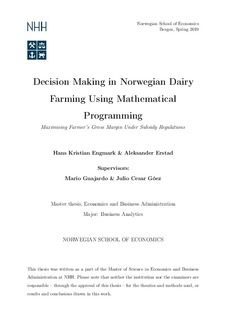Decision making in Norwegian dairy farming using mathematical programming : maximising farmer’s gross margin under subsidy regulations
Master thesis
Permanent lenke
http://hdl.handle.net/11250/2612174Utgivelsesdato
2019Metadata
Vis full innførselSamlinger
- Master Thesis [4372]
Sammendrag
Norwegian dairy farming is characterised by increased consolidation and a wide array of
governmental support schemes. The farming industry can utilise business analytics to
assist the complex decision making facing Norwegian farmers. In this thesis, we develop a
mixed integer linear programming model that maximises the farmer’s gross margin under
farming activity and subsidy constraints.
We use the optimisation model to study a small, a medium, and a large dairy farm located
in Jæren, Norway. We find that all of the three farms have pure dairy cow herds in the
optimal solution. Subsidy’s total share of income is 30.2% lower for the large farm than
for the small farm. We also find that the marginal subsidy amount drops from NOK 2.07
for the small farm, to NOK 0.89 for the medium farm, to NOK 0.52 for the large farm,
representing a decrease of 74.8%. Additionally, we found that a milk quota reduction
from 135 000 litres to 105 000 litres for the small farm results in such a large reduction
of profitability that the farm is better off renting a larger quota to obtain maximal milk
production. Lastly, we found that a milk price reduction of 30% only has implications for
the large farm, which replaces eight dairy cows with eight suckler cows.
This thesis further discusses the use of continuous variables in a farming optimisation
model, as well as milk quota valuations and variable cull rates. In addition to the
optimisation model, the work done in this thesis also includes a separate input handling
system. This sets some basis for further work to develop a fully integrated whole-farm
decision support system for Norwegian dairy farming.
